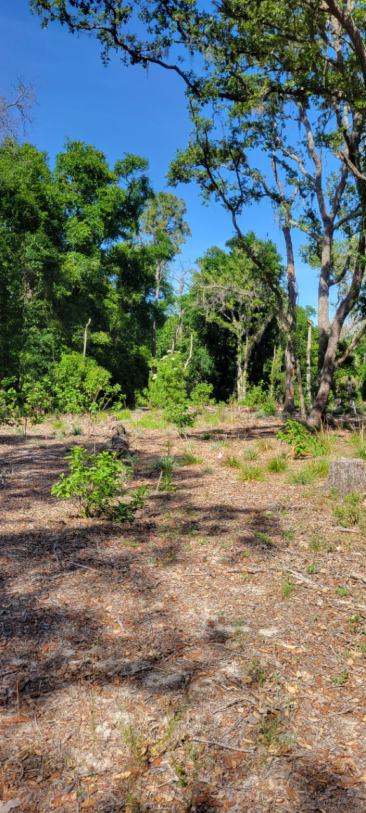
Greetings, readers. I’m thrilled to let you know that my naturalist friend, author Peggy Lantz, recently won an award from the Florida Native Plant Society for her piney woods restoration. She sure deserves it! This post gives the description of the project.
You may remember I published her articles here on my blog, which included many, many, many photos. See some of them at the end of this post.
For the Index to Peggy’s “Caring for Mother Nature” articles published on my blog, click here. Kudos, Peggy!
Peggy’s project: Restoration of Longleaf Pine Woods
The location of this project is Red Gate Road, Orange County, Florida, east of Ocoee and west of Pine Hills. The purpose of the project is to restore a badly overgrown 5-acre woods to its longleaf pine/sandhill habitat to encourage return of gopher tortoises, Lupinus aridorum, and other native species.
Background on the restoration project
A hundred years ago, this 4.9-acre woods was a Longleaf Pine Sandhill habitat. When we bought it in the 1970s, it contained mature and young longleaf pines (including one that had turpentining scars on it), turkey oaks, Garberia, Rosemary, Lupine, and other appropriate sandhill species. Chuck-will’s widows nested in it every summer, along with (in their seasons) Screech owls, a Cooper’s Hawk, Redbellied Woodpeckers, and Flickers. Opossums raised their young in this woods and Coachwhip snakes and Hognose snakes lived in it.
We cut trails through it, and I rode my horse through it regularly. When I no longer owned a horse, the woods overgrew with invasive cherry trees, an Australian pine, grape vines, and air potato vines. I sought assistance from the Forest Service to burn, but housing developments had encroached. I mourned. And then decided to restore it.
When the project began
The project was begun in March, 2021, with clearing of about 3.5 acres of the overgrown 4.9-acre woods. The edges were left alone to screen the project from the lane and neighboring properties, and much debris and many logs were pushed to the edges. Two or three clusters of oaks and some individual oaks were left alive, and remaining unwanted trees were girdled and left to die and feed woodpeckers. Three mature longleaf pines remain in what was a longleaf pine sandhill 100 years ago.
The brush piles were burned and the invasive weeds were herbicided regularly as the chopped-up trees and herbs began to mulch down.
Status in August, 2023
On my 90th birthday, August 8, 2023, 20 three-gallon Pinus palustris trees were planted, along with 10 saw palmettos and 4800 mixed Aristida, Eragrostis, Sorghastrum, and Pityopsis. Also 740 sandhill plants and 400 miscellaneous wildflowers.
Hundreds of feet of hoses and five standing sprinklers were laid out, and that dry summer, fall, and winter I moved hoses and sprinklers almost daily to keep my tiny four-inch plants growing. On days I didn’t turn on the hoses, I would carry gallon jugs of water to give each pine tree a half-gallon drink.
Hand-pulling and herbiciding of invasives continued. And I wondered what would come up from the desirable seeds remaining in the soil. I was not disappointed. Beautyberry shrubs and native passion vines came back profusely. Carolina jessamine covered the trees at the edges in yellow blossoms last winter. I enjoyed eating spring shoots of poke weed, but now they are over-growing, so need pulling. Some native grasses have resprouted, and — best of all — many young lupines are returning. One has already bloomed and borne seeds.
Other good things
A pair of Pileated Woodpeckers raised a brood in one of the dead trees I left standing. So did a pair of Hairy Woodpeckers. An animal has dug a burrow under one of the small piles of cut logs, and rabbits eat the grasses and the maypops and leave the pieces and their droppings on the flat stumps.
All pine trees are growing well, and some have sent up two-foot and three-foot leaders this summer. I’m told not to expect to see any pine trees sprout from old seeds, but I look anyway. The grasses have grown profusely this spring and summer. They are seeding — even the wiregrass — and will be tumbling all over this fall, as they did last year. Flowering species are blooming beautifully.
I never knew it would be such fun to watch grass grow!
Educational outreach
On Earth Day, 2023, I started a series of short articles called Earth Care that appeared weekly in my church’s newsletter until Earth Day 2024. I have written about this project several times for it, and many people have expressed interest and some have come to see it. A sign for it is being prepared. Note from Charlene: Peggy’s Earth Care articles were published on this blog as the series, Caring for Mother Nature, as mentioned at the beginning of this post.
Thanks for reading!
Best wishes from your writer on the wing,
Charlene













Nylda Dieppa
Congratulations to Peggy. what a lovely work of love and well-deserved recognition!
Lucy Cogswell
Peggy is amazing. The knowledge she has about our native landscapes is a treasure and I’m so glad she writes about it so we can all learn. It’s impressive, at 90, the encroaching development has not deterred her from her mission. Congratulations Peggy !
Karen Ozolnieks
Congratulations, Peggy!